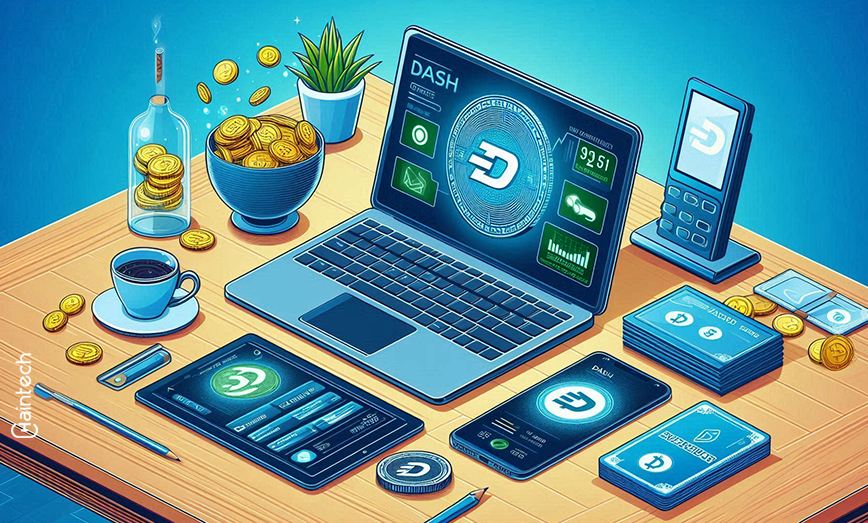Dash – A Digital Cash You Can Spend Anywhere

What is Dash?
Dash is a worldwide digital currency for quick and affordable transactions. On January 18, 2014, software engineer Evan Duffield introduced it under the name XCoin. On March 25, 2015, it decided on its current name after first becoming known as Darkcoin. The word “Dash” combines the words “digital” and “cash,” signifying its goal of becoming a widely used virtual currency.
Unlike a few sporadically used cryptocurrencies, it has a scalable digital payment infrastructure. It combines the ease of using traditional cash with its secrecy. It is a workable digital currency for both novices and pros to use for routine transactions.
This article explains Dash, including its operation and suitability for use with a digital wallet. Find out why Dash can be the best alternative for digital currency.
History of Dash
Dash, a digital currency, has changed significantly since 2014. Evan Duffield created it, originally known as XCoin, and it quickly gained notoriety for offering anonymity options that were not available at the time.
Duffield renamed XCoin to Darkcoin to emphasise its anonymity advantages. The rebranding highlighted Dash’s secrecy advantages and made it a popular darknet currency. Duffield rebranded again after realising this association’s limitations and potential negative consequences.
The coin’s name, Dash, combines “digital” and “cash” to represent its goal of becoming widespread digital money for everyday transactions. Dash separated itself from darknets in 2016 and concentrated on scalable digital payments.
It offers fast, inexpensive payments worldwide with a user-friendly interface and privacy promise.
How does DASH Work?
Dash uses a Bitcoin-like network with some improvements for efficiency and usefulness. Miners and masternodes form a two-tier network.
1. Proof-of-Work Mining:
Miners employ processing power to solve challenging mathematical problems on the first tier. The Dash blockchain receives a new block of transactions when miners overcome these issues. This step protects the network and transactions.
2. Masternodes:
To run a masternode, one individual must verify ownership of 1,000 Dash. Masternodes manage advanced features like InstantSend, which speeds up transactions, and CoinJoin, which mixes transactions for secrecy. Masternodes also vote on it’s development and financing proposals.
3. Reward Distribution:
When a new block is added to the blockchain, the rewards generated are split as follows:
- 45% to miners.
- 45% to masternodes.
- 10% to Dash’s governance budget, which funds future development and community projects.
The DashDirect app lets you buy from numerous stores with this digital cash. It is also traded on Coinbase, Binance, and Kraken.
It is unique and versatile in the evolving field of cryptocurrencies because of its rapid transactions, privacy features, and powerful governance system.
Pros and Cons of Dash
Pros
1. Decentralised Governance:
It is a decentralised system with over 4,500 people voting on important decisions. It is more decentralised than most cryptocurrencies due to its setup and three key decision-making organisations.
2. Consensus Mechanism
It’s governance architecture simplifies decision-making, unlike Bitcoin’s consensus issues. This streamlines network updates and adjustments.
3. Rapid transactions:
It’s “InstantSend” feature sends and confirms transactions in seconds. However, Bitcoin transactions sometimes take an hour to confirm.
4. Improved Privacy:
Cryptocurrency users prioritise privacy. It’s “PrivateSend” function allows anonymous transactions. Better than Bitcoin, which is pseudonymous.
Cons
1. Brand Reputation:
It struggles with its brand identity despite its achievements. After two name changes, it may require another. “Dash” is generic and typically returns unrelated search results, reducing its visibility and recognition.
2. Voter Knowledge:
The Dash community has concerns over the voting process. The low hurdle to becoming a masternode (owning 1,000 Dash) may encourage some voters to make uninformed decisions.
3. Competition:
It faces direct competition from Bitcoin, the original and most well-known cryptocurrency. Other cryptocurrencies, like Ripple, complement Bitcoin, giving it room to expand.
4. Limited Use Cases:
It focusses on digital currency. Ethereum and Ripple, which offer more uses than just trading, might be able to limit Dash’s growth potential.
Differences between Dash cryptocurrency and Bitcoin
Mining Algorithms
Dash and Bitcoin differ mostly in mining algorithms. Bitcoin’s Proof-of-Work (PoW) mechanism forces miners to solve challenging mathematical problems to validate and add transactions to the network. However, It employs the X11 algorithm, which combines eleven hash algorithms. This method is more energy-efficient and secure than PoW.
Managing transactions
Because each Bitcoin node must validate every transaction, transaction times are longer. Bitcoin’s popularity and usage have caused network congestion, higher transaction fees, and delays, making it unsuitable for daily transactions.
Masternodes in Dash solve these difficulties. Masternodes validate transactions and execute other network operations. Each masternode must contain 1,000 Dash to ensure network integrity. It can process transactions faster and more efficiently than Bitcoin, avoiding scaling issues.
Governing and funding
Dash’s governance is more advanced than Bitcoin’s. It’s self-funding approach splits block rewards between miners (45%), masternodes (45%), and a network development and promotion fund (10%). This framework encourages network engagement and funds enhancements and projects. Masternodes can vote on governance and finance proposals, influencing Dash network development.
Privacy
Dash’s CoinJoin mixing service scrambles transactions to hide their sources and destinations. Bitcoin transactions are publicly viewable on the blockchain, but Dash transactions are private.
Conclusion: Is Dash a Good Cryptocurrency?
Dash can improve anonymity in certain places and be a handy payment mechanism. It has maintained a constant market value since 2019, with $32.7 million in 24-hour trading activity as of May 5, 2024. The Dash ecosystem appears to be developing. Your aims, values, and use determine if Dash is a good cryptocurrency. Thus, “Is Dash secure?”
It is like other cryptocurrencies, allows secure, third-party-free transactions. Visa guarantees transaction security and record-keeping when used for credit card payments. Visa’s centralised systems are vulnerable to breaches, putting all users at risk. Recently, hackers attacked banks and financial institutions, highlighting this vulnerability.
Dash’s blockchain-based decentralisation reduces these dangers. To avoid a central authority, 4,943 servers worldwide validate Dash transactions. This decentralised strategy improves security and reduces centralised system risk.
It has many advantages, especially in terms of privacy and security. Based on its market presence and active development community, it appears to be a viable cryptocurrency. However, its usefulness depends on your needs and usage.









